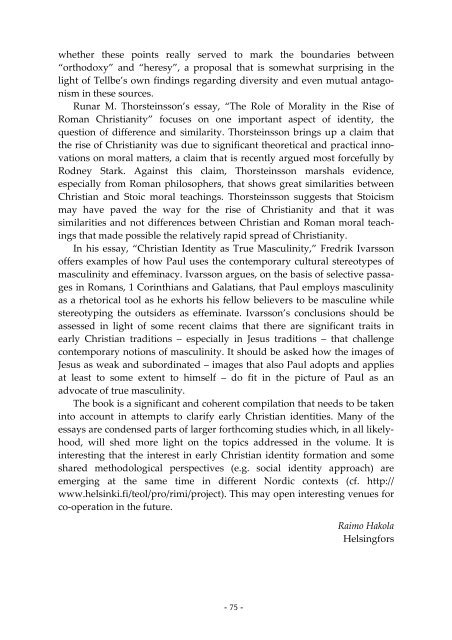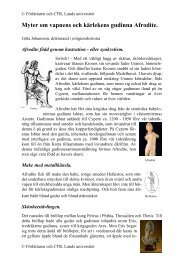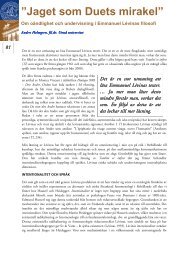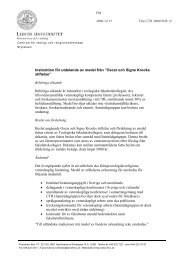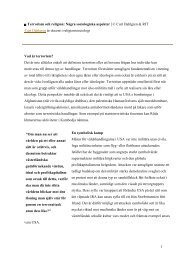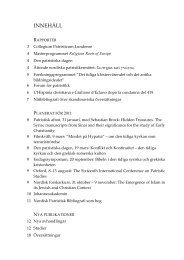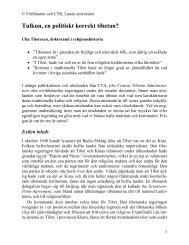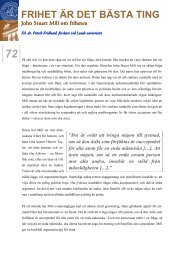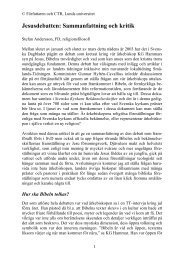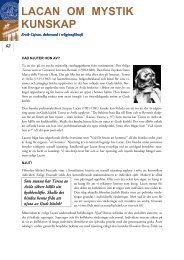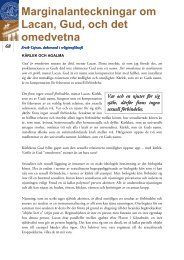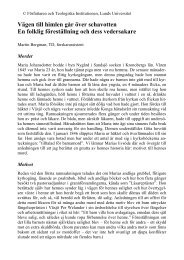Meddelanden 24 (2009) (PDF 780 kB - Nytt fönster) - Centrum för ...
Meddelanden 24 (2009) (PDF 780 kB - Nytt fönster) - Centrum för ...
Meddelanden 24 (2009) (PDF 780 kB - Nytt fönster) - Centrum för ...
Create successful ePaper yourself
Turn your PDF publications into a flip-book with our unique Google optimized e-Paper software.
whether these points really served to mark the boundaries between<br />
“orthodoxy” and “heresy”, a proposal that is somewhat surprising in the<br />
light of Tellbe’s own findings regarding diversity and even mutual antagonism<br />
in these sources.<br />
Runar M. Thorsteinsson’s essay, “The Role of Morality in the Rise of<br />
Roman Christianity” focuses on one important aspect of identity, the<br />
question of difference and similarity. Thorsteinsson brings up a claim that<br />
the rise of Christianity was due to significant theoretical and practical innovations<br />
on moral matters, a claim that is recently argued most forcefully by<br />
Rodney Stark. Against this claim, Thorsteinsson marshals evidence,<br />
especially from Roman philosophers, that shows great similarities between<br />
Christian and Stoic moral teachings. Thorsteinsson suggests that Stoicism<br />
may have paved the way for the rise of Christianity and that it was<br />
similarities and not differences between Christian and Roman moral teachings<br />
that made possible the relatively rapid spread of Christianity.<br />
In his essay, “Christian Identity as True Masculinity,” Fredrik Ivarsson<br />
offers examples of how Paul uses the contemporary cultural stereotypes of<br />
masculinity and effeminacy. Ivarsson argues, on the basis of selective passages<br />
in Romans, 1 Corinthians and Galatians, that Paul employs masculinity<br />
as a rhetorical tool as he exhorts his fellow believers to be masculine while<br />
stereotyping the outsiders as effeminate. Ivarsson’s conclusions should be<br />
assessed in light of some recent claims that there are significant traits in<br />
early Christian traditions – especially in Jesus traditions – that challenge<br />
contemporary notions of masculinity. It should be asked how the images of<br />
Jesus as weak and subordinated – images that also Paul adopts and applies<br />
at least to some extent to himself – do fit in the picture of Paul as an<br />
advocate of true masculinity.<br />
The book is a significant and coherent compilation that needs to be taken<br />
into account in attempts to clarify early Christian identities. Many of the<br />
essays are condensed parts of larger forthcoming studies which, in all likelyhood,<br />
will shed more light on the topics addressed in the volume. It is<br />
interesting that the interest in early Christian identity formation and some<br />
shared methodological perspectives (e.g. social identity approach) are<br />
emerging at the same time in different Nordic contexts (cf. http://<br />
www.helsinki.fi/teol/pro/rimi/project). This may open interesting venues for<br />
co-operation in the future.<br />
- 75 -<br />
Raimo Hakola<br />
Helsingfors


